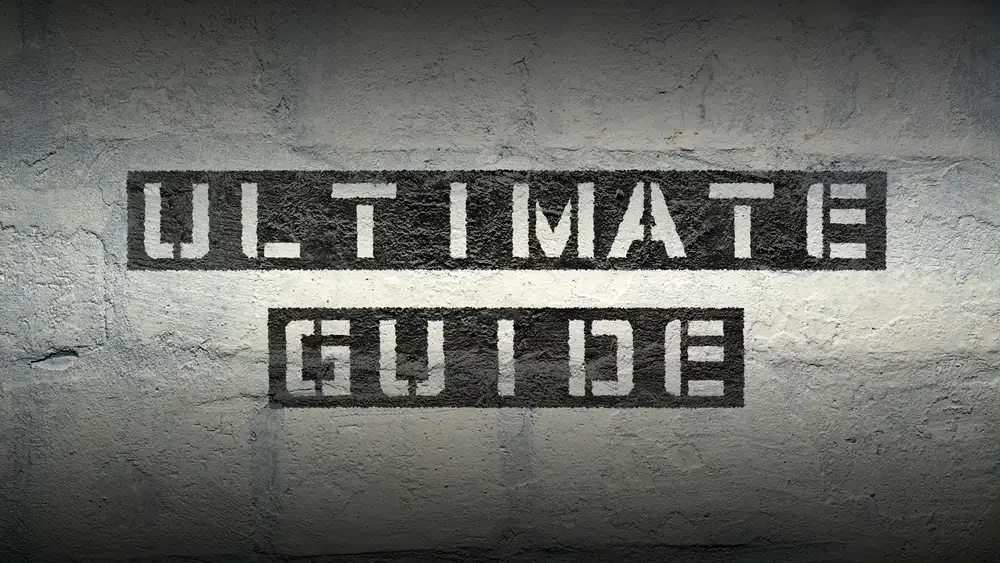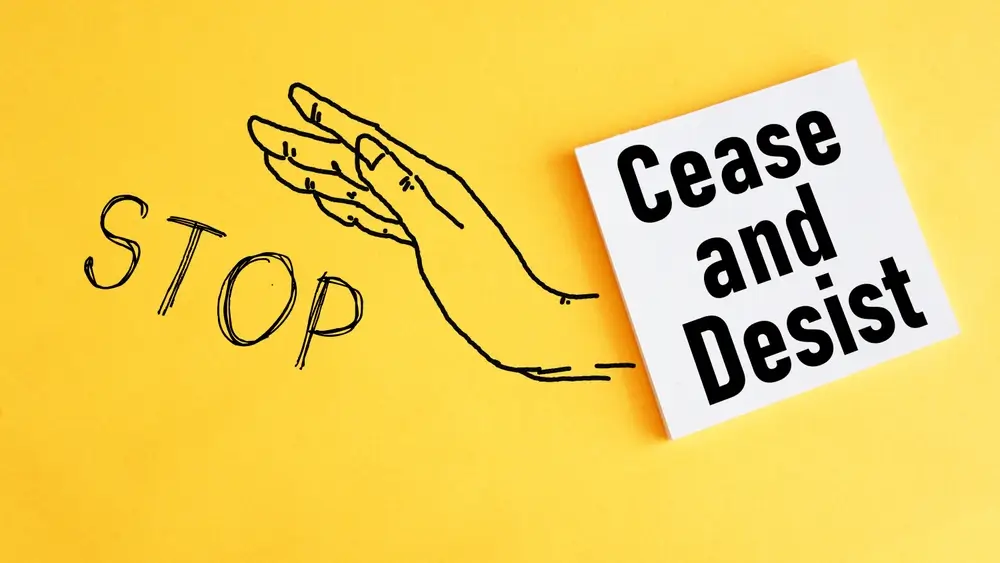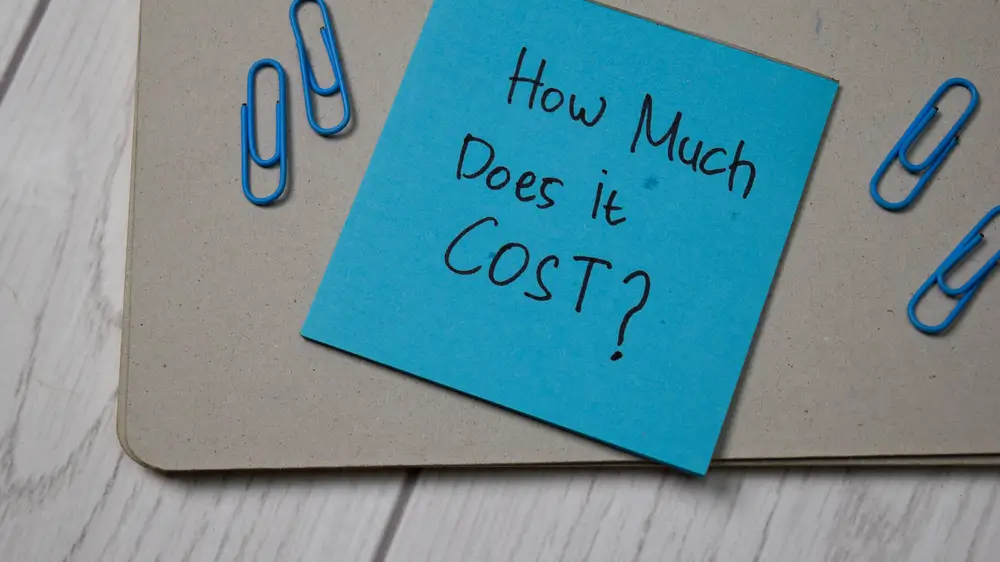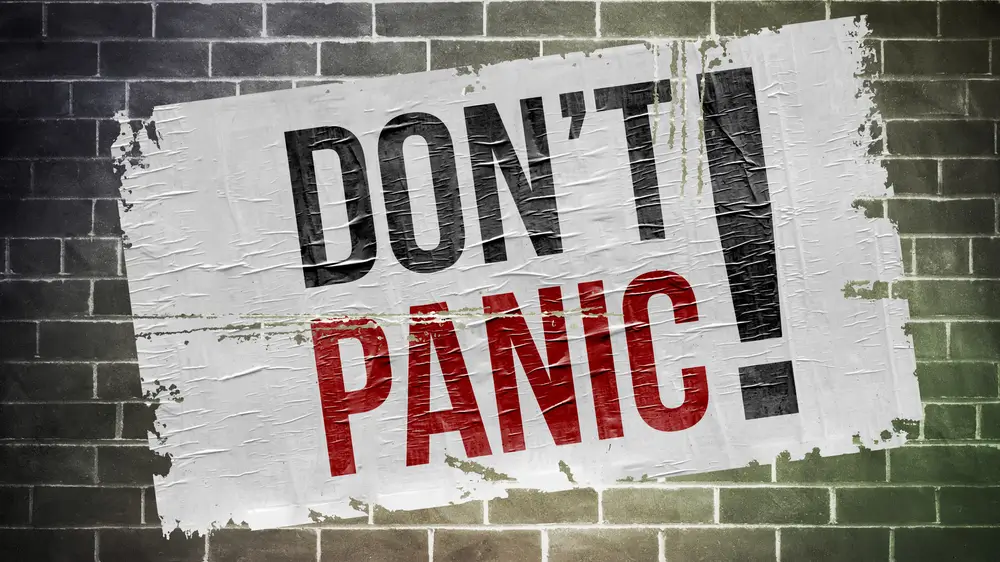
This site is reader-supported. We may earn a small commission if you make a purchase from one of our partners.
If you’ve ever been on the receiving end of a strongly-worded Cease and Desist letter, you may feel like the world is about to end.
Few things in life instill fear quite like a Cease and Desist letter. Sending a powerful C&D letter can help you quickly get the relief you need from harassment, defamation, infringement of intellectual property, or any other type of civil dispute.
In this article, we will look at everything you need to know about Cease and Desist letters, including the types of letters you can send, how best to write them, and what you should do first if you ever receive one.
What is a Cease and Desist letter?

A Cease and Desist letter is a demand letter sent to an individual or business that is engaging in some form of unwanted behavior.
The purpose of the letter is to get the recipient to stop or change their behavior immediately. In many cases, it will also include a warning that if the behavior does not stop, legal action will be taken.
It’s important to note that a Cease and Desist letter is not a legal document. It is simply a way to resolve a situation without having to engage a law firm and pursue legal action.
And because a strongly-worded letter is easy to produce and often effective, it’s typically the first choice for individuals or businesses when it comes to dispute resolution.
When a Cease and Desist Letter is Appropriate

If you have a civil dispute and you are thinking of sending a C&D letter, it’s essential to consider whether your situation warrants it. Here are three elements to consider before you send your message:
Type of Dispute
Disputes typically fall into two broad categories.
The first is the personal dispute. Personal disputes are those that exist between two individuals. The two most common types are harassment and defamation of character.
The second is the business dispute. Business disputes are those that involve a business and typically involve infringement (such as trademark or copyright infringement) or breach of contract.
If your dispute falls into one of these two categories, it would typically be a good fit for a Cease and Desist letter.
Validity of Dispute
One of the critical factors in deciding whether to send a Cease and Desist letter is whether your dispute is a valid one.
For instance, if you have documented examples of slander or harassment, or if you have a business contract that has obviously been breached, then you have a solid basis to a demand letter.
However, if you knowingly send a Cease and Desist letter to someone with a false claim, you could end up facing your own harassment claim.
Severity of Dispute
These letters have a formality and seriousness that can make people fearful. They should only be used for serious disputes that have the potential to be seriously damaging to you as a person or to your business. Don’t waste time with C&D letters for minor or trivial disputes that can be easily solved with a quick conversation.
Is it Ever a Bad Idea to Send a Cease and Desist Letter?

Yes, you can get yourself in trouble if you aren’t careful.
Cease and Desist letters come with serious implications, typically the threat of legal action. For instance, if it comes to light that you are sending these letters to a Trademark owner with false claims in order to intimidate or coerce a particular response, you may open yourself up as the target of legal action. This could come in the form of a harassment accusation or possibly a restraining order.
Before you send any Cease and Desist letter, make sure that you have a solid claim so that you don’t get yourself into any trouble.
Types of Cease and Desist Letters

There are many different reasons that you might need a Cease and Desist letter:
Harassment Cease and Desist Letters
A Harassment Cease and Desist letter covers situations where you are experiencing harassment directly or indirectly from a person (or group of people). This can include any different type, including workplace, online, or sexual harassment.
Harassment is one of the most common reasons for sending such a letter and is also one of the situations where they are most effective. In an era where harassment laws are getting more attention, this type of letter can be a powerful asset in changing behavior.
Defamation Cease and Desist Letters
A Defamation Cease and Desist letter helps you deal with situations where you are the subject of either slander or libel, regardless of whether it’s in person, online, or in the media.
To help clarify the differences:
- Slander refers to the type of defamation that is spread by word of mouth. So if someone is spreading falsehoods about you verbally, this would be considered slander.
- Libel refers to defamation that is either recorded or broadcast in some way. For instance, if someone were to publish a social media post about you or repeat falsehoods in a television interview, this would be considered libel.
In either situation, a demand letter can not only help you avoid future defamation but can also help you retract information that is already out in the open.
Infringement Cease and Desist Letters
An Infringement Cease and Desist Letter is useful when you need to protect your intellectual property from use by an infringing party and outline the legal consequences that could be forthcoming. This can take one of three forms:
- Trademark infringement: Trademark infringement is when someone is using one of your trademarks without authorization. This typically happens in print (signs, flyers, etc.) or online (web and email marketing. Before you involve a trademark lawyer, a trademark Cease and Desist letter can help you solve the problem. Just be ready to provide proof that you are the trademark owner in the form of your trademark registration number.
- Copyright infringement: Similar to the first example, this is when a third party is using intellectual property that you have a copyright for. This includes written and recorded material that belongs to you. Again, be prepared to provide proof that you own the copyright to add weight to your demand letter.
- Patent infringement: In this example, you discover that someone is using a technique or design that you hold a patent for. In this case, a strongly-worded Cease and Desist letter that provides your patent details and proof of the infringement of your intellectual property can help everyone avoid further legal action.
When faced with infringement of your intellectual property rights, it’s important to act swiftly and decisively. A Cease and Desist letter can help you do just that.
Debt Collector Cease and Desist Letters
A Debt Collector Cease and Desist Letter is designed to help you get relief from your shady debt collectors who may be making harassing calls to your home, work, or friends. Debt collection services or agencies in the United States are required by law to follow the Fair Debt Collection Practices Act (FDCPA), which outlines both your legal rights when dealing with debt collectors as well as what they are permitted to do. If you feel you are being illegally harassed, a Cease and Desist letter is an effective tool to help get the relief you need.
Contract Cease and Desist Letters
A Contract Cease and Desist Letter will help you when you are experiencing issues with a signed contract. These issues typically fall into one of two categories:
- Breach of Contract: If you have a signed contract and the other party is willfully ignoring or breaking the terms, this is considered a breach of contract.
- Tortious Interference: This refers to a situation where a third party is interfering with a contract you have with another person or business. This may happen when they want to steal a customer or cause your performance to drop.
Property Cease and Desist Letters
A Property Cease and Desist Letter covers situations where there is a property dispute between two parties. These disputes often come in two varieties.
- Trespass: Trespass occurs when someone steps onto property you own without permission. This can happen accidentally or purposefully and may require a letter if it is frequently the same individual entering onto you property.
- Property Encroachment: This refers to someone building or extending a structure onto property that you own. If this happens, it’s important to take quick action as removing a built structure can be challenging and could damage your property.
Social Media Cease and Desist Letters
A Social Media Cease and Desist Letter is meant to help stop harassment and defamation that happens over social media. With the explosion of sites like Facebook, Twitter, Instagram, and TikTok, it’s extremely easy to be exposed to bad behavior online. Chances are, you or someone you know has been victimized by this type of behavior in the past.
Former Employee Cease and Desist Letters
A Former Employee Cease and Desist Letter is used when you have a former employee who is slandering your company, breaking your enforceable non-compete agreement, or disclosing your IP and trade secrets to an unauthorized third party. A strong letter can help you resolve the matter quickly and avoid further action or litigation.
Neighbor Cease and Desist Letters
A Neighbor Cease and Desist Letter can be used to help quell a dispute you have with a neighbor. If your neighbor is trespassing or encroaching on your property, harassing you or your family, or spreading defamatory information, you need a way to stop the behavior and outline the possible consequences.
Landlord Cease and Desist Letters
A Landlord Cease and Desist Letter can use used in situations where your landlord is either ignoring the details of your lease or is otherwise ignoring local housing regulations. Using such a letter is faster and cheaper than involving attorneys and litigation.
Tenant Cease and Desist Letters
A Tenant Cease and Desist Letter is aimed at helping landlords resolve issues with their tenants. This can include breaking a signed lease, harassment, or property damage. A letter requests changes in the tenant’s behavior to ensure the peace and security of those that live in the house or building.
Roommate Cease and Desist Letters
A Roommate Cease and Desist Letter can be used to help correct behavior by a roommate. If your roommate is verbally abusive, refusing to abide by your tenancy agreement, or is violating your lease, a forceful letter can help you correct the situation quickly.
Do I need a lawyer to write and send a Cease and Desist letter?

Contrary to popular belief, you do not need an attorney or law firm to write and send a Cease and Desist letter for you. You typically have three options to choose from.
- First, you can write and send the letter yourself. This is the least expensive approach but also carries less weight than a professional, third-party letter.
- Second, you can use a template from an online provider to quickly and easily get a professional letter created. We recommend LawDepot, but there are others you can find online.
- Finally, you can hire an attorney to write and send the letter. This is the most expensive option, but it comes with the advantage of having an attorney ready to help deliver the legal repercussions if the letter is ignored.
Regardless of what happens, if your letter causes the recipient to react adversely and you need legal help, an attorney will almost certainly be required.
How Much Does A Cease and Desist Letter Cost?

The cost of a Cease and Desist Letter will depend on how you choose to have it written and delivered. Here are the main options:
The DIY Approach
If you choose to write the letter yourself, there is no cost other than the price of postage (if you are sending it by mail). This is a great option if you are on a budget, and there are template options available on many different websites.
However, this option poses a risk in terms of both quality and effectiveness. You will need to have stellar writing chops to have a powerful effect and overcome the lack of professional, third-party letterhead.
Average cost: $10 (for postage and supplies)
The Freelance Writer Approach
If you don’t want to write it yourself, you can always look for a freelancer to write it for you. A freelance writer can vary in both cost and quality depending on where they live and their English proficiency. You can find freelancers on sites like Upwork fairly easily, but as with anything, it’s buyer beware.
And as with the DIY approach, if you want your letter professionally signed, you will still need to fine someone to do that for you, likely at an additional fee.
Average Cost (Offshore writers): $25
Average Cost (US / CDN writers): $150
The Template Approach
In our opinion, the best approach for creating a Cease and Desist letter is to use an online provider like Law Depot. This way you can get a professional letter at a fraction of the cost.
Average Cost (US / CDN writers): $25 – $50$
The Lawyer Approach
If you have a large budget and need to involve an attorney from the beginning, you can ask a lawyer to draft the letter for you. The obvious benefit is that lawyers can be very effective in producing results. The downside is that they can be very costly and often work at an hourly rate.
Expected Cost: $1,000-$10,000
What Should Be Included In A Cease and Desist letter?

Now that you know how much a cease and desist letter will cost let’s take a look at what should be included in one.
Every C&D letter is different because they are all tailored to the specific situation of the sender. However, there are some key elements that every good C&D letter should have:
- A clear explanation of the problem
- A demand for resolution
- A deadline for compliance
- A threat of legal action (if necessary)
- Your contact information
- Signature
Let’s break each of these down so you can see how they would work in a real-life situation.
1. Problem Statement
The first part of your letter should state the problem clearly. This might include things like trademark infringement, libel, slander, or copyright infringement. If you have supporting information (such as screenshots of the defamation or registration numbers for your trademark), they should be included here.
2. Demand For Resolution
The second part of your letter should state your demands in clear and concise language. This might include a demand that the recipient stops their specific behavior or take some other action to rectify the situation.
3. Deadline For Compliance
The third part of your letter should set a deadline by which the recipient must comply with your demands. This deadline should be reasonable, depending on the severity of the offense and the necessary actions required for resolution.
4. Threat Of Legal Action (Optional)
In the fourth part of your letter, you may threaten to pursue legal action if the recipient does not comply with your demands within the set deadline. This is usually included as a last resort to protect your rights if you feel an amicable option isn’t realistic. The threat to file suit should not be your first response and should only be used if other options have been exhausted.
5. Your Contact Information
The fifth part of your letter should include your contact information so the recipient can get in touch with you to resolve the issue. This might include your name, address, phone number, and email address.
6. Signature
The sixth and final part of your letter is the signature and the letter should be signed by you or your representative. This signature verifies that the contents of the letter are true and accurate to the best of your knowledge.
Are Cease and Desist Letters Enforceable?

C&D letters are not legally binding, but they are still an important way to help protect your legal rights. When properly drafted, they can be very effective in stopping harmful behavior and getting a resolution without going to court.
However, because demand letters are not legally binding, the recipient is not required to comply with the demands set forth in the letter. If the recipient does not comply, you may need to take further legal action to resolve the issue.
And while a Cease and Desist Letter isn’t legally enforceable, a Cease and Desist order is.
What is a Cease and Desist Order?
A cease and desist order is a legal order issued by a court of law, government agency, or regulatory body and it requires the recipient to stop a specific behavior immediately.
Cease and desist orders are typically issued in cases of defamation, harassment, or infringement. These orders are different from Cease and Desist letters in that they are legally binding. This means that if the recipient does not comply with the order, they may be brought to court to face the consequences.
Three Ways To Send A Cease And Desist Letter

Now that we’ve gone over what should be included, let’s take a look at the three most common ways to send a cease and desist letter.
Via Certified Mail (Recommended)
The first way to send a Cease and Desist letter is by certified mail. This ensures that the recipient gets the letter and also provides you with proof of delivery. It costs a bit more than standard mail, but you will receive a delivery receipt to prove it was delivered.
Via Email
The second way to send a Cease and Desist letter is by email. This is a good option if you need to send the letter quickly, but it doesn’t provide you with proof of delivery.
In Person
The final way to deliver a Cease and Desist letter is in person. This is the least favorable option as it means you are likely to be in direct contact with the person or people you are in conflict with.
What Happens After You Send A Cease And Desist Letter?

Once you’ve sent a Cease and Desist letter, there are three possible outcomes.
The recipient stops the behavior
If the recipient stops the behavior, then the issue is resolved, and no further action is necessary. This is the best possible scenario
The recipient doesn’t stop the behavior but responds to your letter
If the recipient doesn’t stop the behavior but responds to your letter, then you can try to resolve the issue amicably. This might involve negotiating a resolution or coming to an agreement on what constitutes acceptable behavior going forward.
The recipient doesn’t respond to your letter
If your cease and desist letter is ignored, then you may need to take further legal action. This could involve filing a lawsuit or going to court to get a cease and desist order.
You should always consult with an attorney before taking any legal action. An attorney can help you determine the best course of action and increase your chances of success.
What To Do If You Receive A Cease And Desist Letter

First off, don’t panic.
If you receive a demand letter, you need to take time to understand what the demand is and whether you want to (or need to) comply.
Ultimately, you should probably consult an attorney if you receive a letter like this. They will be able to help guide you through the process of responding and whether you have grounds to fight the accusations.
Conclusion
A Cease and Desist letter is a formal demand that asks the recipient to stop a specific behavior. These letters are not legally binding, but they can be effective in getting the recipient to comply with your demands.
If you’ve been the victim of harassment, defamation, or infringement, then you may want to consider sending one. And if you do, we can help.
If you are looking for a powerful Cease and Desist letter to help solve your problem, check out Law Depot to help get the relief you deserve.

Wes Talisman is a freelance journalist who helps answer common legal questions for everyday people. He’s never won a Pulitzer Prize, but he does write a stellar Cease and Desist letter.